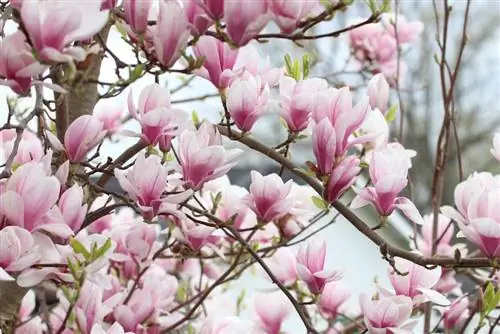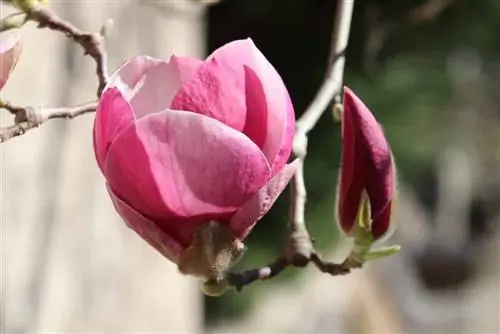- Author admin [email protected].
- Public 2023-12-17 03:39.
- Last modified 2025-01-24 12:45.
Magnolias in the garden are the heralds of spring in our latitudes. Because they produce their decorative flowers in late winter and early spring, then the warm season is not far away. In order for the magnolia tree to continue to bloom every year, it must also be pruned correctly. However, too much of its branches should not be taken away; it prefers to remain in a more natural growth state. Therefore, the right cut is very important in order to get a decorative tree in the front yard or garden.
Cutting materials
Just cutting the magnolia at the same time is a big mistake. The hobby gardener should also prepare for this with his cutting materials. Therefore, such pruning, which only occurs every few years, must be carefully thought out. If you only have blunt scissors or saws when it comes to cutting materials, you should get the right material in advance from a well-stocked specialist retailer. These include, above all, sharp pruning or pruning shears. Saws with their grooved saw blades and dull scissors leave unclean and, above all, often frayed interfaces. These should not be avoided just because of their appearance. Bacteria or fungi can also penetrate here more easily. You should also pay attention to the following when using cutting tools:
- always disinfect before cutting
- pure alcohol can be used for this
- Special disinfectant also available in well-stocked specialist retailers
- new tools should also be disinfected
- use pruning shears for smaller branches
- Use pruning shears for thicker branches
- Always choose the right tool so that the branches are not crushed
Tip:
Hygiene is just as important as the ideal time when pruning the magnolia. Therefore, every hobby gardener should be particularly careful and not forego it because of, for example, time savings. Since the tree is not cut often, this time can be spent once every four to five years.
Cut correctly
It is important that the magnolia is cut correctly, according to the instructions. If it is cut too often or incorrectly, it can do more harm than good to the decorative tree. Because it should always maintain its growth habit. The crown is simply thinned out; symmetry should be given priority. Ideally, the tree is cut by two people, so one can cut and the other can see from below where it needs to be cut. There are other things you should consider when making a cut:
- If at all, then only use scissors every four to five years
- remove shoots competing with the main trunk
- also cut crossing and inward-directed shoots
- However, diseased and dead shoots should be removed every year
- cut the crown into an attractive shape
- As a rule, this is only lightened slightly
- the tree is already growing in a beautiful shape
- only change this if there is no other option
The cutting technique is also crucial to ensure that the tree is not damaged. Therefore, you should always proceed with absolute caution and precision:
- always cut off the branches directly at the trunk
- The magnolia then thickens the bark at this interface by itself
- This is a wound healing mechanism
- if any remains of the branch remain, it cannot be used
Tip:
A magnolia should always be cut with restraint and caution. The motto here is, less is more. Above all, it does not require annual pruning as it is a very slow-growing tree. If a cut needs to be done, the cut branches can be used as cuttings for new small magnolia trees.
Avoid large interfaces

Especially when entire branches have to be cut off that have already grown very thick, this can become a problem for the decorative tree. Spores or fungi can easily penetrate large wounds. In this way, the life expectancy of the magnolia can be significantly reduced. Once this disease has penetrated the tree, it spreads quickly. In the worst case scenario, the ornamental tree can no longer be saved. Therefore, after cutting very thick and wide branches, if this cannot be avoided, you should always proceed as follows:
- coat with a fungicidal tree wax
- is available at any good garden store
- How to avoid wound infections
- Spores and fungi cannot penetrate
- Regular monitoring of wound closure is important
- therefore check the tree regularly throughout the year
- If cracks appear, close immediately
- use the fungicidal tree wax again
Time
The best time to prune is late spring or early summer, directly after flowering. This varies from area to area. Because in milder areas, a magnolia tree blooms earlier than in those where frost still prevails for a long time. This gives the tree enough time to cope with the cut for the rest of the year. If pruned later in the year, the tree will most likely not produce flowers next spring. Therefore, the ideal time to prune the magnolia is as follows:
- in spring
- when the flowers wither and fall off
- choose a frost-free day
- these can still occur until May
- never cut in the rain
- this promotes fungal formation at the interfaces
- the fungi enter the plant unhindered through the wound
- an overcast but warm spring day is ideal
Tip:
In areas that still expect frost in May, such as the Ice Saints, you should wait until after these days to cut the magnolia. In milder areas, pruning can be done earlier if the tree is no longer flowering.
Raising to be a standard man
The wild magnolias are actually better placed under the bushes than under the trees. If they are not pruned early on, they will grow in height as well as in width. The lower branches also touch the ground. Hobby gardeners who want to cultivate a magnolia despite a lack of space in the garden can also train it to form a standard tree. Pruning must be done more often, especially in the young years of the plant. The procedure here is as follows:
- forming the shoots
- Remove all new shoots regularly along the desired trunk
- do not leave branch stubs standing
- cut from the trunk without leaving any residue
- protect the areas with fungicidal tree wax
- only if branches are completely removed, no new shoots will form
- these water shooters look very ugly
- plus they keep forming again
- cut the rest above the trunk into a decorative crown
Tip:
Straight purple, star and tulip magnolias can be trained into a standard tree. These are often already offered in stores with a standard tree.
Autumn cut

Of course, unlike many other trees and shrubs, a magnolia should only ever be pruned in spring, but under certain conditions autumn pruning may also be necessary. Pruning can and must be carried out at any time, even in autumn, if:
- this is storm damage
- sick or dead trees must be removed
- the entire tree is threatened by a fungal disease
In these cases, the pruning can also be more radical. However, the tree then needs a certain amount of regeneration time before it will fully bloom again in spring. In such a case, this can take two to three years or even longer. Unfortunately, trees that are radically cut back after storm damage or fungal infection cannot always be saved. But in these cases the hobby gardener has no other choice, but this rescue operation is definitely worth a try.
Tip:
Sick and dead branches can and should be completely removed at any time of the year, as they unnecessarily rob the magnolia of light and strength.
Radical pruning
For example, after a fungal attack or storm damage, radical pruning often has to be done, which should otherwise always be avoided. However, this should only ever be a very special exceptional situation. The hobby gardener then needs a lot of patience until the magnolia develops into a stately tree or bush again. This can take several years. The flowering is also only moderate to complete several years after a cut. When radically pruning, you should proceed as follows in order not to damage the magnolia any more than necessary:
- Cut scaffolding shoots except for three to five new shoots
- leave more shoots on thick branches
- also cut all shoots that grow inwards or over each other
- make sure that all damaged or fungal branches are removed
Consequences of Improper Cutting
The magnolia is not exactly easy to care for when it comes to cutting. As a rule, it doesn't need any pruning at all. If it is cut improperly, it will hardly be appreciated and it will even have unpleasant consequences. Therefore, the hobby gardener should always follow instructions if the magnolia needs or should be cut. The consequences could be as follows:
- If the remains of cut branches remain, water shoots form
- these grow steeply upwards
- must always be cut out afterwards
- do not make a radical cut if it is not necessary
- the magnolia has a natural growth that should be maintained
- especially young plants are very damaged by a radical cut
- The number of flowers next year will decrease significantly
- especially if cut too late in the year
- after a year of pruning, the magnolia often shows few or no flowers at all
- the natural, decorative growth is damaged
Tip:
Magnolias that are grown in pots must not be cut. Only dead branches should be removed here.
Conclusion
Magnolias become beautiful, decorative trees in local gardens if they are pruned correctly. But here, in contrast to many other plants, the motto is: less is more. Because the tree can only really develop well and reveal its full beauty if it is not cut. If it needs to be cut into shape, then every few years is enough. Because it grows very slowly and, above all, by itself, just as the hobby gardener imagines a magnolia tree to be. The right time to prune immediately after flowering is also important so that the tree can recover over the course of the year and show new, decorative and, above all, lots of flowers next spring.

